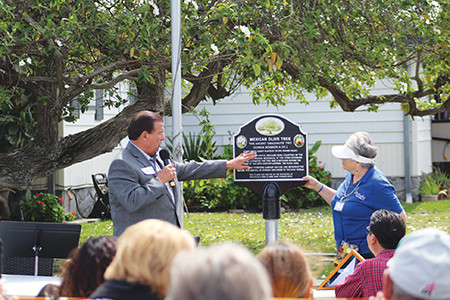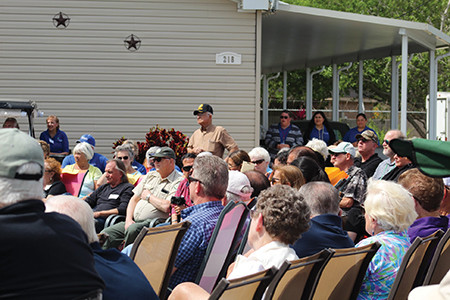 Palm Resaca Mobile Home Park in Brownsville recently unveiled a plaque recognizing the oldest known anacahuita (Mexican Olive Tree) in the United States. Seven hundred years. The plaque reads that the tree was a seedling before the turn of the 15th century and, therefore, mature and reproductive before the arrival of Spanish explorers.
Palm Resaca Mobile Home Park in Brownsville recently unveiled a plaque recognizing the oldest known anacahuita (Mexican Olive Tree) in the United States. Seven hundred years. The plaque reads that the tree was a seedling before the turn of the 15th century and, therefore, mature and reproductive before the arrival of Spanish explorers.
“It’s incredible as we mere mortals gaze on a majestic Mexican olive tree, to fathom life that has flourished for 700 years,” said Dianne Miller, park resident.
Senator Eddie Lucio, Jr. presented the park with a Texas State Flag and an award in recognition of the tree on Friday, March 6.
“The tree is the oldest of its kind in the United States,” he said proudly, “and we are very delighted to have it here in Brownsville.
Roy Reyes, the Brownsville City Forrester, presented the park with a “Tree City USA” flag. Brownsville has been designated as a tree city for 20 years. The city encourages developers to preserve as much vegetation as possible around new builds. He added that preservation efforts and events such as this help give the City of Brownsville that recognition.
Both flags will fly prominently beside the tree.
Tree Committee Chairperson Beryl Stovell received the awards on behalf of the park.
“We put a lot of hard work into making this event happen and we are very proud of our efforts,” stated Stovell.
UTRGV professor Andrew McDonald, a noted botanist, gave an impassioned speech about how important it is to preserve the native trees and plants in Texas. It was McDonald who determined that the tree was 600-700 years old, meaning it predates the arrival of the Spanish in North America.
The native name for the tree is anacahuita. The Mexican olive tree usually grows to a height of 30 feet. The one in the park is 35 feet tall. It has large, soft, dark leaves and large, showy, trumpet shaped white flowers.
The northern limit of the tree is South Texas because it can’t tolerate cold winters.
The professor also encouraged park residents to consider using native plants to revitalize their Resaca.
UTRGV emeritus professor and historian Anthony Knopp, said “This is from pre-history, the period from which we have no recorded information. It’s clear that the weather was cooler and wetter than it is now.”
Knopp said thousands of years ago, the Rio Grande River passed through where the tree is now. The Gulf of Mexico was also 400 feet higher – modern day Brownsville would have been under water.
Thrilled to find such a gemstone of creation in her own backyard, Stovell said, “It is absolutely wonderful to be one of the custodians of one of the most ancient anacahuita trees there is, and it’s in our park. We all admire and love its constant blossoming.”
Park neighbor Alden Moore recounted that at one time, one of the park residents wanted to tree cut down because its leaves were making too much of a mess on his lawn.
“Fortunately for everyone, this didn’t happen,” said Moore. “or we would have lost a national treasure. Now it’s our job to nurture this tree and protect it. It will be a lasting legacy for our children.”
This grand sprawling olive tree continues to bloom, shade and inspire the residents of Palm Resaca Park and now occupies its rightful place as a matriarch of North American nature.
If you wish to see this tree, please call the park office at (956) 546-7423 or (800) 667-6881. The office will arrange a time for you to come and visit.













